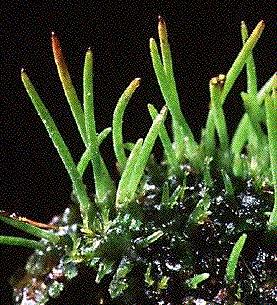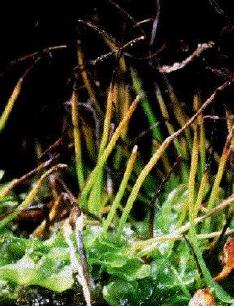


Most people are unaware of hornworts, though they are a quite common and widespread group of plants which may be found in tropical forests, along streamsides, and in disturbed fields around the world. Most species are small and unassuming greasy blue-green patches, but some tropical species can cover large areas of soil or the sides of trees. Because of their unique morphology, there have been many questions about relationships and origin of the Anthocerotophyta.
The group's common name "hornwort" refers to the tall narrow sporophytes which are embedded in the top of the plant. As in other bryophytes, the sporophyte remains attached to its parent gametophyte throughout its life, but unlike these other plants, the sporophyte continues to grow throughout its life; this happens as a group of cells at the base of the horn divide repeatedly. This continuous growth from a near-basal meristem is unique among plants to hornworts.
As the sporophyte grows longer, it splits into two halves lengthwise, releasing the spores as they mature. Along with the spores are cells called pseudoelaters, which change shape as they dry out and thereby assist in scattering the spores.
When a spore germinates, it produces a flat thalloid plant with a greasy blue-green color and odd morphology. The best way to recognize a hornwort, and especially to tell it apart from a liverwort or fern gametophyte, is to look at the plant under a low-power microscope; hornworts will generally have a single large chloroplast per cell. This is an especially useful character for sterile material, but you must look at fresh material, since hornworts tend to dry up and fall apart if not kept moist, and will quickly rot if immersed.
The oldest hornwort fossils are spores from the late Cretaceous (Maastrichtian), which have been compared to the spores of the living genus Phaeoceros. A somewhat older fossil, Notothylacites filiformis, has been described as a hornwort from the Santonian (Late Cretaceous) of Czechoslovakia, but the identification of the fossil as a hornwort is not entirely certain -- the fossil preserves the whole plant, but in rather poor detail, and might be better interpreted as a liverwort. Most hornwort fossils are Miocene spores found in Europe and assigned to the Anthocerotaceae.
Such a late date for oldest fossils of hornworts is curious, considering that most cladistic analyses of living plants suggests that the group originated early in the history of land plants, probably before the Devonian, and should be one of the oldest lineages of plants. The presence of a columella, or small column of tissue, running up through the center of the capsule is reminiscent of mosses and of "rhyniophytes", such as Horneophyton, and further supports the idea of an early divergence. The delicate hornworts may not have been easily preserved, which might explain the absence of a Paleozoic record. However, it seems puzzling that their spores, which would be much more likely to be preserved, are not encountered either.


Above, you can see pictures of the hornwort Phaeoceros. On the left is a plant with young sporophytes beginning to elongate from the top of the gametophyte. On the right is a plant with older sporophytes, which have split open and begun to release spores. Click on either picture to see an enlarged version.
There are usually two or three families recognized in the Anthocerotophyta, as listed below. Because of the uncertain relationships of fossil hornworts, only living taxa are included in the list here.
ANTHOCEROTALES
For additional information about hornwort classification, visit the Tree of Life. You can also view hornwort images at the University of Wisconsin, the source of the images used here (by permission).
Or for additional information about bryophytes in general, try the homepage of the American Bryological and Lichenological Society.

P. Kenrick. 1994. Alternation of generations in land plants: new phylogenetic and palaeobotanical evidence. Biol. Rev. 69: 293-330.

